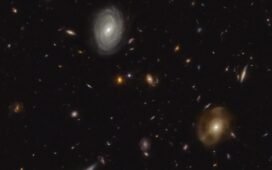Could life be widespread throughout the cosmos, in the subsurface oceans of ice-covered worlds? NASA’s Europa Clipper mission investigates.
With such large numbers of planets, moons, stars, and galaxies present within the observable Universe — so many of which have been confirmed to have similar raw ingredients to those found in our own Solar System — it seems inevitable that alien life must be out there somewhere. How are we going to find it? In general, there are two main methods that astronomers are leveraging today.
- SETI, and SETI-like efforts, that look directly for signals, largely in the radio portion of the electromagnetic spectrum, that could potentially indicate the presence of intelligent extraterrestrials. Any signal of a non-astrophysical origin, or that shows characteristics of it willfully being sent Earthwards, would be revolutionary.
- Similarly, astronomers using methods like direct exoplanet imaging or transit spectroscopy could reveal potential biosignatures, or at least what we might more responsibly call “bio-hints,” that would leave their mark on an inhabited planet’s atmosphere.
However, there’s a third method that’s generally underappreciated: looking up close…















